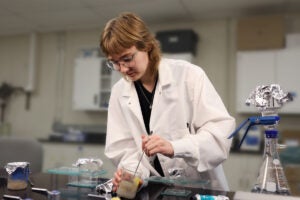The year was 1995. Bill Clinton, a Democrat, had campaigned for the presidency on the promise to end welfare as we knew it. The Republican party had just taken control of Congress. The Personal Responsibility and Work Opportunity Reconciliation Act would be signed into law the following year.
To many of its critics, the “welfare reform” law, as it became known, represented a scaling back of the national commitment to alleviating poverty. Recipients were required to seek work in order to receive benefits. They were limited, in most cases, to receiving benefits for no more than two years in a row, and no more than five years over a lifetime. States were allowed more freedom to experiment with methods of disbursement and requirements for participants. In many cases, that meant lower benefits and more obstacles to receiving them.

To the collaborators on the New Hope anti-poverty project–among them Dr. Aletha Huston, professor of human development and family sciences in the School of Human Ecology at The University of Texas at Austin–welfare reform was more than just a challenge. It was an opportunity. Things were changing. States and cities were experimenting. If it was inevitable that some places would make bad decisions about how to help (or not help) the poor, it was also inevitable that some places would improve on the old system.
If New Hope, which was based in Milwaukee, could demonstrate in practice its belief that generous assistance, combined with a careful structure of incentives and disincentives, could help lift people out of poverty, perhaps it could help the country move past the old and bitter argument between left and right.
For three years, from 1995-97, New Hope provided earnings supplements, health care subsidies, child care subsidies, job search assistance, and in some cases, jobs, to hundreds of poor Milwaukee residents who were willing to work at least 30 hours a week.
During the program, and for years after, a team of researchers followed the participants to discover whether New Hope’s combination of support and work requirements led to better outcomes compared to a control group of poor Milwaukeeans who had access to the state of Wisconsin’s aid programs but not to the additional benefits that New Hope provided.
“The results were encouraging,” says Dr. Huston, who joined the New Hope team in 1995 to conduct academic and policy analysis of the program’s effects. “Not only did New Hope families show modest economic gains, but their children, on average, did better in school and had fewer behavior problems.”
These gains were documented by Huston and her two co-authors in Higher Ground: New Hope for the Working Poor and Their Children, which was published in 2007.

Higher Ground also put flesh on its analytical narrative by telling the stories of three Milwaukee women–“Lakeisha,” “Inez” and “Elena”–who participated in the New Hope anti-poverty project.
Each of the three women had made a lot of decisions that had contributed to their poverty. They’d dropped out of school early. They’d had kids too young. They’d dated, married and had children with abusive, addicted or unreliable men. Each of the women, however, had demonstrated impressive persistence in the face of tough realities–terribly dysfunctional childhoods, addicted or abusive parents, bad schools and rough neighborhoods–that were beyond their control.
“We have often have a very simplistic notion of who these people are,” says Huston. “There’s a simplistic conservative perspective that says that it’s the people’s fault that they’re in this situation. They’re unskilled. They’re unmotivated. They make bad decisions. They’ve made their own beds. There’s also a simplistic liberal idea that says that it’s all the fault of the social structures they’re dealing with. Society doesn’t provide them with the right opportunities to prosper. Well, it’s obviously both.”
Lakeisha had had three kids by the age of 20, but while participating in New Hope discovered the fortitude to hold down a job, take care of her kids and form what would grow into a stable, long-term romantic relationship with a new partner.
Elena, who’d immigrated to the United States from Central America when she was 13, had three young kids by two different fathers. She spent too much money, and she often had violent fights with her husband. Yet she’d also managed to stay in school during her first pregnancy, and to work full time and take care of three kids by herself after her husband was sent to jail.

Inez, as she’s described in Higher Ground, is both the stereotypical welfare recipient and the stereotypically individualistic, striving American. She was raised on welfare, and she became a young mother of two kids by two different men (one of whom ended up in prison for dealing drugs), but she is also optimistic, fiercely ambitious and reluctant to rely on anyone else for help.
“On paper, Inez’s life looks like a replay of her mother’s,” write Huston and her co-authors. “But a few minutes with Inez made it clear that that history would not dictate her destiny. She was feisty, energetic and forever finding ways to improve her work and family life. She saw work as a central part of her life and brimmed with confidence about her future career.”
The effects of New Hope, says Huston, tended to reflect the different situations of the people who participated. People who were working very little, or not at all, when they signed up with New Hope, worked more and made more, on average, than their control group counterparts during the three years they were getting assistance. After the program ended, however, these gains receded, and soon they were working and earning at rates comparable to the control group.
People who were working full-time when they joined New Hope saw, on average, no gains in earnings relative to the control group of those who had full-time employment. A number of them used the New Hope wage supplement as a way to cut back on the overtime hours they worked so they could spend more time with family.
“A third group,” write Huston and her co-authors, “falls in the middle–those like Elena and Inez who faced only one or two significant but not insurmountable barriers to full-time employment.”

This group, which included about half of the participants, saw gains in income and employment not just for the three years of the program, but two, five and eight years later.
“Indeed, five years after New Hope ended,” write Huston and her co-authors, “the employment rates of the program group were 14 points higher than those of the control group. Earnings were significantly higher as well.”
For the children of New Hope participants, there were long-lasting gains as well. Two and five years after the program ended, New Hope children had better grades and better test scores than children from the control group. Eight years later, those gains had faded relative to the control group, but the New Hope students were still, on average, more engaged in school, more likely to have jobs of their own and less likely to be cynical about work.
These results, says Huston, are consistent with what’s been observed across a number of studies since the welfare reform of the mid-’90s.
Work is important, these studies have shown, but so is public assistance that rewards people for moving into the workforce.
“If you really want to get people out of poverty, then some public money has to go into increasing the income of people who are working,” says Huston, who’s been part of a team analyzing the results of 10 programs, including New Hope, that emerged from the wake of welfare reform. “You’re not going to help everybody, no matter what you do, but you can change the odds quite a bit.”
The other major pattern that Huston and her colleagues have observed is that putting kids in center-based child care, as opposed to home-based care, seems to improve the prospects of the children.

“The home-based care that people got was often pretty unstable,” says Huston. “They patched together the boyfriend and the grandma, but then grandma got a job, and then the neighbor stepped in, and then they couldn’t do it anymore. On average, center care is more likely to have planned learning experiences. It’s more likely to be more stable.”
Life for Elena, Lakeisha and Inez, at least as of 2004, seemed to reflect a positive, though modest, shift. Lakeisha and Inez were still poor, but they were working, and their personal lives had stabilized. Lakeisha was still with the man she’d met while in New Hope, and Inez was slowly working her way through college. Elena was in her eighth year of a job with the same company, and was earning more than $35,000 with full benefits. She still spent too much money, however, and her personal life was chaotic. Inez’s kids were doing relatively well in school. Lakeisha and Elena’s daughters were doing well in school, but their sons weren’t.
Huston is uncertain about whether the nation is getting any better at responding to poverty through policy.
“We’re not talking a lot about poverty,” she says. “It seems to have disappeared as an issue. We’ve become more willing to give people things like food stamps and health care, and to subsidize child care. The Earned Income Tax Credit has increased enormously. A lot of states have been doing things that we know work better. A lot of things have happened essentially under the radar.”
For Huston, one of New Hope’s lessons is that it’s possible to offer support to people without compromising their dignity or undermining their sense of autonomy.
“Every one of us is operating within a system,” she says, “and part of what we do depends on what’s available out there for us to do. It’s not different for people who are poor. You can either make it really, really hard for people, or you can make it a little bit easier for those people who are going to take those steps, and try harder. You can make it work for them.”



